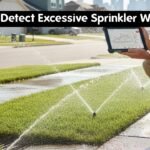Ever found yourself staring at your lawn, wondering why it’s either too dry or too soggy? Choosing the best sprinkler heads for lawns can be a game-changer for your lawn’s health and appearance. Let’s dive into how to select the right sprinkler heads for your unique lawn needs. From rotary to micro-irrigation, we’ll cover all the bases to help you make an informed decision.

Unpacking Sprinkler Heads: What You Need to Know
Rotary Sprinklers: The Heavyweights of Coverage
How They Work: Picture a sprinkler head that spins around, watering everything in its path. That’s a rotary sprinkler for you. It’s like a water-blasting whirlwind that delivers coverage over a broad area.
- Gear-Driven Rotary: These are the workhorses. They’re quiet and can be adjusted for different spray patterns. Great for large lawns where you want an even spread.
- Impact Rotary: These might make a bit more noise, but they’re incredibly durable. Perfect for high-pressure situations where you need strong, consistent coverage.
Pros:
- Wide Reach: Ideal for big, open spaces.
- Adjustable Patterns: Customize the spray distance and direction.
Cons:
- Pressure Dependent: If your water pressure isn’t great, these might struggle.
- Coverage Issues: Sometimes, you might need to fiddle with settings to cover odd-shaped lawns effectively.
Who Should Use Them: Once installed, fine-tune spray patterns for full coverage. Need help? Learn how to adjust sprinkler heads for optimal water coverage.
Oscillating Sprinklers: The Versatile Fans
How They Work: Oscillating sprinklers move back and forth, creating a fan-like spray that covers a rectangular area.
Pros:
- Even Distribution: Fantastic for medium-sized lawns with a rectangular shape.
- Adjustable Coverage: You can tweak the width and length of the spray.
Cons:
- Limited Reach: They’re not the best for very large or irregular lawns.
- Pressure Sensitivity: If your water pressure is low, the spray might be weak.
Who Should Use Them: Medium-sized, rectangular lawns where even coverage is desired.
Pop-Up Sprinklers: The Hidden Gems
How They Work: These sprinklers are installed underground and pop up when activated, making them ideal for areas where aesthetics matter.
Pros:
- Visually Discreet: Perfect for landscaped areas where you don’t want sprinklers to be visible.
- Customizable Coverage: You can adjust the spray patterns to suit specific garden layouts.
Cons:
- Maintenance Required: Regular cleaning and adjustments are necessary.
- Complex Installation: More involved compared to simpler sprinkler types.
Who Should Use Them: Gardens and landscaped areas where you want a clean look and specific watering needs.
Micro-Irrigation Systems: Precision Watering Experts
Micro irrigation systems deliver water directly to plant roots, saving water and boosting crop growth. They reduce soil erosion and support better nutrient management, though they need regular maintenance (Micro Irrigation System Concepts, Advantages, Disadvantages … YouTube · ICID CIID · 26 Oct 2020). Check for youtube video below:
How They Work: Micro-irrigation systems focus on delivering water directly to plant bases. Think of them as the VIP treatment for your plants.
- Drip Emitters: These deliver water slowly and steadily, perfect for flower beds and vegetable gardens. Flow rates typically range from 0.5 to 2 gallons per hour.
- Soaker Hoses: They release water gradually along the length of the hose. Ideal for garden beds and rows.
- Micro-Sprayers: These cover a bit more area and are used for ground covers and shrubs.
Pros:
- Efficient Water Use: Minimizes waste by targeting the root zone directly.
- Great for Diverse Plant Types: You can customize watering for various plants.
Cons:
- Limited Coverage: Not suitable for large lawns.
- Clogging Risks: Emitters can get clogged and need regular maintenance.
Who Should Use Them: Flower beds, vegetable gardens, and any area where precise, efficient watering is needed.
What to Consider When Choosing Sprinkler Heads
Choosing the right sprinkler heads ensures even water coverage and healthy lawns. Testing different heads helps identify the best fit for your yard’s shape and soil type (How to Choose Sprinkler Heads | How to Test Which Sprinkler … YouTube · American Irrigator · 27 Sept 2019). Check for youtube video below:
Lawn Size and Shape
- Large Lawns: Rotary and oscillating sprinklers work best.
- Irregular Shapes: Pop-up or micro-irrigation systems adapt well.
Soil Type
- Sandy Soil: Drip systems are perfect to prevent runoff.
- Clay Soil: Adjustable sprinklers can help manage the water flow.
Water Pressure
- High Pressure: Suitable for rotary and oscillating sprinklers.
- Low Pressure: Pop-up and micro-irrigation systems are more effective.
Climate and Weather Conditions
- Wind: High winds can affect spray patterns. Use fixed or rotating sprinklers with adjustable nozzles.
- Climate: Dry climates benefit from drip systems that conserve water.
Water Quality
- Hard Water: Drip systems may require regular maintenance to prevent build-up.
Budget
- Economical Choices: Basic pop-up or oscillating models.
- Invest in Efficiency: Higher-end systems provide better features and efficiency.
DIY Installation: A Handy Guide
Basic Steps:
- Plan Your Layout: Sketch out your lawn and decide where each sprinkler head will go.
- Install Sprinklers: Position rotary or oscillating heads for broad coverage. Pop-up heads should be level with the ground. For micro-irrigation, place emitters close to plant bases.
Tools and Materials:
- Sprinkler Heads: Pick based on your lawn’s needs.
- Pipes and Connectors: For water distribution.
- Shovel or Spade: For digging trenches if necessary.
Tips:
- Follow Instructions: Each system has specific installation requirements.
- Test Coverage: Run the system and adjust as needed for even watering.
Designing Your Sprinkler System
Effective Layout:
- Spacing: Ensure sprinklers are spaced to cover the entire area without gaps.
- Zones: Divide your lawn into zones based on different watering needs.
Calculating Water Needs:
- Consider Plant Types: Different plants need different amounts of water.
- Adjust Settings: Modify based on seasonal changes and weather conditions.
Smart Sprinkler Systems: The Future of Watering
Benefits:
- Weather-Based Adjustments: Automatically adjusts watering based on real-time weather and soil conditions.
- Efficiency: Reduces water waste and saves on utility bills.
Features to Look For:
- Connectivity: Smart systems often sync with smartphones for easy control.
- Sensors: Soil moisture sensors ensure precise watering.
conclusion
Selecting the right sprinkler head can turn a patchy lawn into a lush, healthy landscape. By understanding the options—from rotary beasts to micro-precise drippers—and learning how to tweak them properly, you’ll stretch your water dollar and boost curb appeal.
Try out a few types, adjust to your landscape, and keep an eye on performance. If a head stops working or looks clogged, don’t panic—sprinkler head replacement is easier than you think.
So, dive in, experiment, and see which system works best for your lawn. Share your experiences or ask questions in the comments below—let’s get those lawns looking their best!










